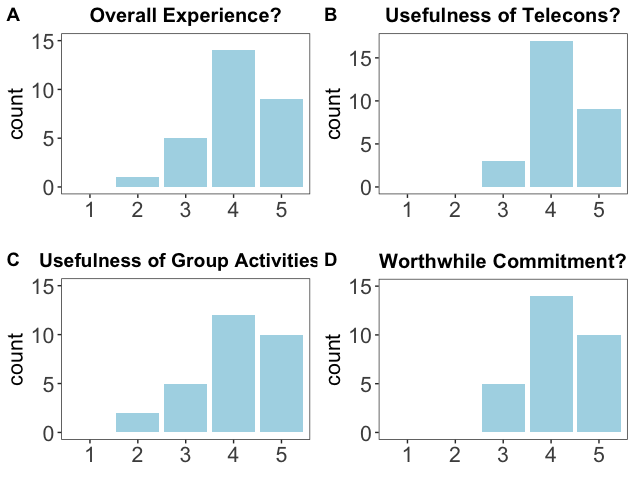Hollings intern, Natalie Baillargeon, shares their summer research study involving MAPP Task Forces
This summer, I, Natalie Baillargeon, interned with NOAA through the Ernest F. Hollings Undergraduate Scholarship. I am a rising senior at Smith College, studying Environmental Science and Policy. I worked with the Modeling, Analysis, Prediction, and Projections (MAPP) program on a review of their Task Forces (TFs), which are nearing their tenth anniversary. MAPP is a competitive research program that advances climate modeling capabilities and applications; it is housed in NOAA’s Office of Oceanic and Atmospheric Research (OAR) Climate Program Office (CPO).
TFs, created in 2011, are a group of mostly MAPP-funded scientists working for about three years on a specific research area, such as drought or climate model development. Each scientist is funded separately for their own projects, but the TFs allow for organization around a topic in the hopes of completing larger-scale initiatives. My goal was to learn the successes and challenges of the TF model as well as possible improvements.
To complete this review, I came up with five sub-projects: collect basic information, learn who is participating, analyze the citation count for publication, conduct interviews, and send out surveys. I completed the basic information in the first few weeks of my internship while I was getting familiar with the TFs. Then, I created a large spreadsheet for basic information for each TF, such as funded projects and special issues. A special issue is a collection of papers around a topic published in a journal; most are only open to TF but occasionally are open to the public. Table 1 is a sub-set of the large spreadsheet I made.
Table 1. General information about each TF.
| Title | Years | Project Count | Special Issue? (Y/N) | Biggest Accomplishments |
| Subseasonal to Seasonal | 2016-2019 | 19 | Y | Worked applied to the 3-4 week forecast tool |
| Model Diagnostics l | 2015-2018 | 9 | Y | Process-Oriented Model Diagnostic special issue |
| Model Diagnostics lI | 2019-2022 | 8 | Y | Process-Oriented Model Diagnostic special issue |
| Drought I | 2011-2014 | 11 | Y | Received the DOC Silver Medal Award |
| Drought II | 2014-2017 | 14 | N | California and Great Plains Assessments |
| Drought III | 2017-2020 | 15 | Y | Temperature-drought relationship report |
| Drought IV | 2020-2023 | 11 | NA | TBH |
| Marine Prediction I | 2017-2020 | 8 | Y | Organizing a special issue |
| Marine Prediction II | 2020-2023 | 13 | NA | TBH |
| CMIP6 | 2019-2022 | 13 | Y | Organizing a special issue |
| Climate Reanalysis | 2013-2016 | 7 | N | |
| Climate Prediction | 2012-2015 | 13 | Y | NMME seasonal prediction experiment |
| CMIP5 | 2011-2014 | 16 | Y | Worked applied to Climate Special Report |
| Climate Model Development | 2014-2017 | 10 | Y | Climate Forecast System Version 2 special issue |
| Climate Sensitivity | 2020-2023 | 7 | NA | TBH |
For the participation sub-project, I wanted to learn how many scientists were participating in multiple TF iterations. TF iterations are those that are related by theme, such as Drought I, II, III, and IV. I found that about ¼ of scientists participate in multiple TF iterations. I found this number appropriate as most of the scientists in each iteration are new, allowing them to have this opportunity. Yet, it also maintains some scientists already in iterations to help maintain progress.
For the citation count sub-project, I compared the number of citations for MAPP-funded publications in special issue publications versus non-special issue publications. I looked at papers just in 2018 because there are too many publications in total to look at since the start of TFs in 2011, and 2018 had a good number of special issue publications. I found that there was no significant difference between citation counts of special issue publications versus non-special issue publications.
I conducted 24 interviews with leads and co-leads of the TFs to learn about their experience and recommendations for TFs moving forward. Each interview was around 30-minutes or less, and I asked questions about the best practices, successes, challenges, and recommendations. These conversations were very helpful when creating recommendations for TFs going forward.
Finally, I sent out a survey to participants in the TFs ending this year, Drought III and Marine Prediction. The survey asked questions to learn about their TF affiliation and career stage. They also were asked four scale questions to rank different aspects of TF (the overall experience, usefulness of telecons, usefulness of group activities, and worthwhile commitment). Both the responses by TF affiliation and career stage were reflective of the pool of respondents. Finally, there were a few questions about the successes, challenges, and recommendations for TF. Figure 1 has the responses from the scale questions; a majority of the respondents were satisfied with all the parameters of the TFs. The written results also were very helpful when coming up with a list of recommendations.


Figure 1. Scale questions (1 is the worst, 5 is the best). 29 responses.
From these sub-projects, it is clear that TFs are successful in meeting their goals. However, from this project, I was able to synthesize results and came up with nine recommendations for TFs moving forward. Some of the recommendations revolve around making the objectives of TFs clearer, providing funding for in-person meetings, and giving more freedom to the scientists to explore current events and new collaborations involving non-funded participants.
MAPP is already taking steps to address these recommendations. For example, new language was already added to the FY21 MAPP Information sheets to clarify expectations. MAPP will also now allow the use of UCAR workshop funds for TF-led events and is exploring paper fee incentives for cross-project collaborations.
After completing this review, I put together a report, PowerPoint presentation, and a poster. I created a poster presentation to present at the American Geophysical Union 2020 Fall Meeting; I may also present at the American Meteorological Society 2021 Annual Meeting.



